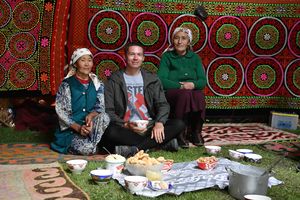Duvakin Evgeny Nikolaevich
18 April 1986, Kirov, Kirov Oblast
Biography, education, career:
In 2008 Evgeny Duvakin graduated from the History Department of the Vytka State University for the Humanities, Kirov. In 2011 he earned the Candidate of Sciences degree in Folklore Studies from the Russian State University for the Humanities, Moscow. His teachers in science are Yuri Berezkin, Leo Klejn, and Vladimir Korshunkov. In 2011–2012, he was a visiting scholar at the Department for the Anthropology of the Americas (Altamerikanistik) at the University of Bonn. Since 2014, he has been working together with Yuri Berezkin on the worldwide electronic database on folklore and mythology. Since 2017, he is a Research Fellow at the Department of the Anthropology of the Americas, Peter the Great Museum of Anthropology and Ethnography (Kunstkamera), Russian Academy of Sciences. His fieldwork experience includes documentation of endangered Ket and Evenki dialects in Western Siberia (August – September 2009), study of folklore traditions of the Khalkha and Darkhad in Central and Northern Mongolia (July – August 2011), and archaeological investigations of Bronze Age sites in Central and Western Mongolia (since 2015, during the summer months).
Research Interests:
Archaeology, History and ethnography of the peoples of Central Asia, History and ethnography of the peoples of Siberia, the Extreme North, and the Far East, History and ethnography of the peoples of North and South America, Mythology, Folklore studies, areal distribution of folklore and mythological motifs in historical perspective; ethnographical and iconographical links between Eurasian and Native American cultures; reconstruction of culture of the early inhabitants of the New World.
Publications:
· Evenki folklore texts from the Laboratory for Computational Lexicography Archive, Lomonosov Moscow State University. Antropologicheskij forum, 2014, No. 23, pp. 167–184 (in Russian).
· Buried in a head: African and Asian parallels to Aesop’s fable. Folklore (London), 2016, Vol. 127, No. 1, pp. 91–102 (with Yuri Berezkin).
· The captive khan and the clever daughter-in-law. Folklore (Tartu), 2016, Vol. 64, pp. 33–56 (with Yuri Berezkin).
· A Yakut folklore parallel to a legend from the Stele commemorated Idiquts of Qocho (1334). Vostok (Oriens), 2016, No. 6, pp. 17–26 (in Russian).
· Transparent people: Areal spread of some concepts of beauty in the Old World. Etnograficheskoe obozrenie, 2017, No. 4, pp. 24–39 (in Russian).
· Ancient Greek – Latin – Caucasian mythological links in the Eurasian context. Indo-European Linguistics and Classical Philology, 2018, Vol. 22, pp. 452–463 (in Russian).
· Ket shaman drums from the Kunstkamera and the Ethnographic Museum of the Kazan University. Siberian Historical Research, 2019, No. 1, pp. 144–173 (in Russian).
· Celtic – Caucasian folklore parallels and possible scenarios of their origin. Indo-European Linguistics and Classical Philology, 2019, Vol. 23 (in Russian).
· The electronic analytical catalogue of folklore and mythological motifs: Thematic classification and areal distribution (with Yuri Berezkin, since 2016, in Russian).


